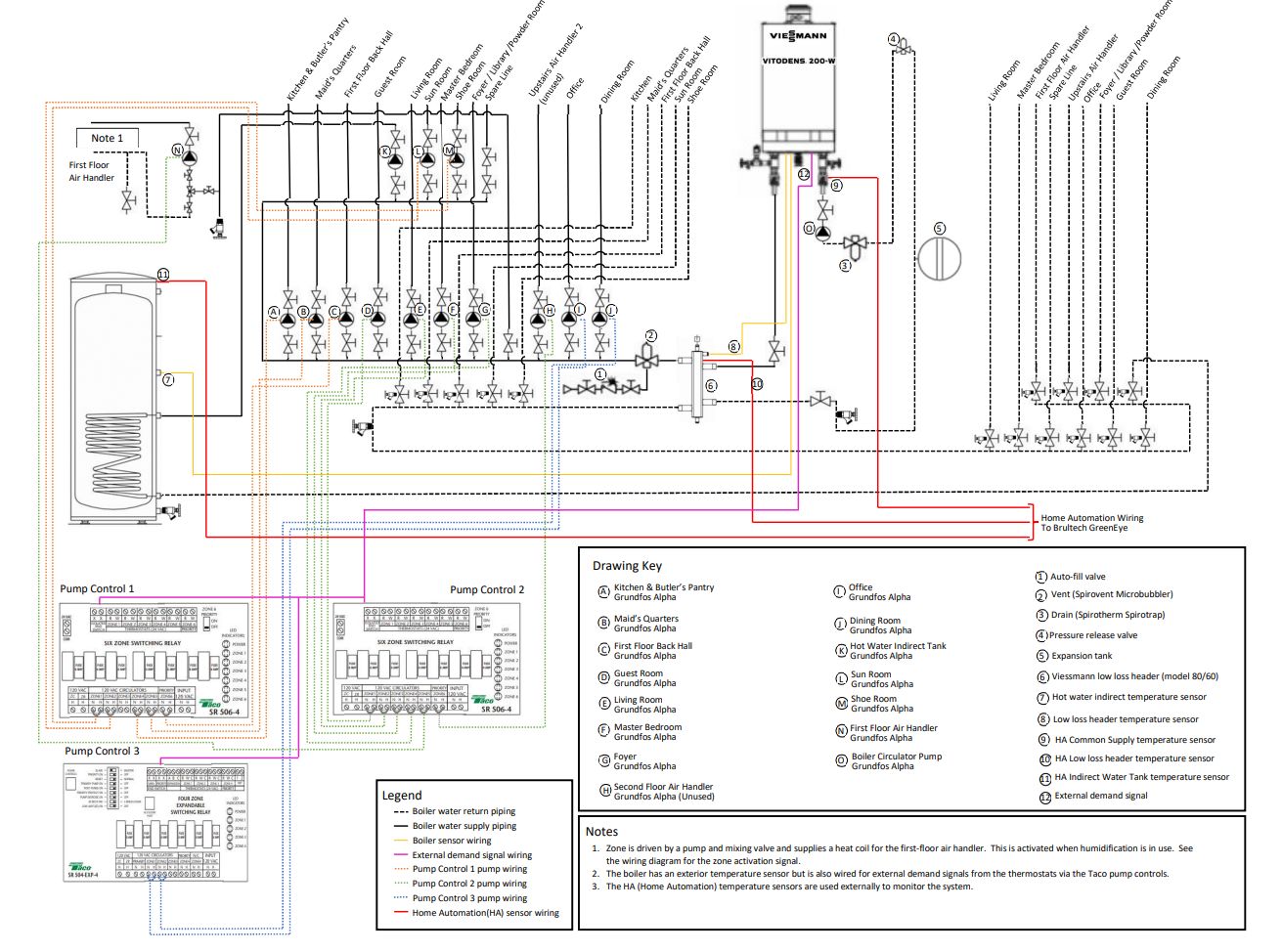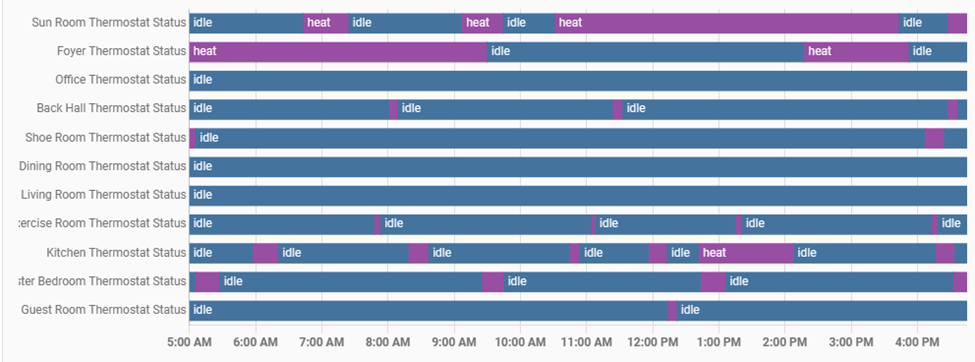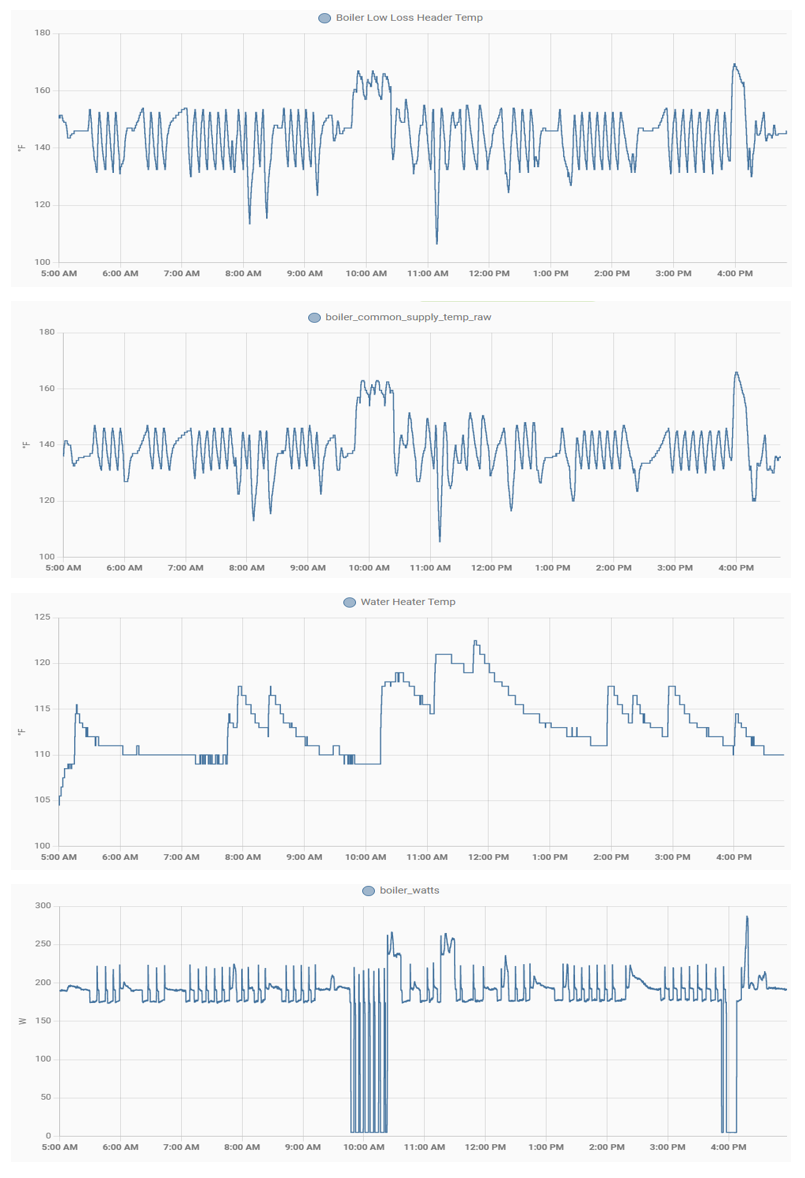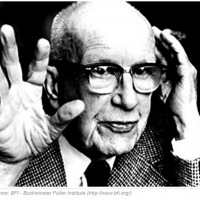Welcome! Here are the website rules, as well as some tips for using this forum.
Need to contact us? Visit https://heatinghelp.com/contact-us/.
Click here to Find a Contractor in your area.
If our community has helped you, please consider making a contribution to support this website. Thanks!
Do I need a Buffer Tank in this system?
Options
ChrisMcc
Member Posts: 28
Hello,
I have a somewhat open ended question but what it amounts to is I'm trying to figure out if I would benefit from a buffer tank on my heating system.
I have a fairly large system (IMO) that consists of a Viessmann boiler and 12 zones, 11 of which are old cast iron radiators that were existing. Each zone is serviced by a Grundfos Alpha pump. The system also has an indirect hot water tank. It's somewhat complicated so I'll attach a diagram as built.
We have extensively insulated the house and I feel like it's a little over-zoned at this point. I get calls from zones to turn on the heat, mostly one at a time, and there is very little draw from the zones compared to what the boiler seems to create. I'll attach a graph that shows when each zone was calling for heat (doesn't count hot water heater) during a 12 hour period today.
What seems to happen is that the boiler starts and almost immediately the return water is close to the same temp as the heated water at the low loss header. I have temp sensors on the low loss header (boiler output) common supply to the boiler, and hot water heater. I can also see when the boiler runs based on the power draw. I'll attach one more image that shows all of these for the same 12 hour period as the heating calls.
It seems like a bad thing that the dT on the header and supply is so low. It also seems bad to me that when there's no external demand from heating zones the boiler short cycles making hot water as you can see.
I'm wondering if I should look into a buffer tank to store the water that the boiler is making so the boiler itself doesn't have to cycle on and stay on when there's plenty of energy in the system. I really don't know how to approach this so I'm interested in opinions, ideas and questions.
I have a somewhat open ended question but what it amounts to is I'm trying to figure out if I would benefit from a buffer tank on my heating system.
I have a fairly large system (IMO) that consists of a Viessmann boiler and 12 zones, 11 of which are old cast iron radiators that were existing. Each zone is serviced by a Grundfos Alpha pump. The system also has an indirect hot water tank. It's somewhat complicated so I'll attach a diagram as built.

We have extensively insulated the house and I feel like it's a little over-zoned at this point. I get calls from zones to turn on the heat, mostly one at a time, and there is very little draw from the zones compared to what the boiler seems to create. I'll attach a graph that shows when each zone was calling for heat (doesn't count hot water heater) during a 12 hour period today.

What seems to happen is that the boiler starts and almost immediately the return water is close to the same temp as the heated water at the low loss header. I have temp sensors on the low loss header (boiler output) common supply to the boiler, and hot water heater. I can also see when the boiler runs based on the power draw. I'll attach one more image that shows all of these for the same 12 hour period as the heating calls.

It seems like a bad thing that the dT on the header and supply is so low. It also seems bad to me that when there's no external demand from heating zones the boiler short cycles making hot water as you can see.
I'm wondering if I should look into a buffer tank to store the water that the boiler is making so the boiler itself doesn't have to cycle on and stay on when there's plenty of energy in the system. I really don't know how to approach this so I'm interested in opinions, ideas and questions.
0
Comments
-
A couple simple ideas. If the boiler and its pump only start on a heating call, I would move the sensor 12 or so inches downstream from the LLH. The boiler should see the system load more so than the LLH load.
Can you merge some of the zones together and do some balancing at the manifold.
Most of the higher end boilers have a lot of features to help eliminate shot cycling. Ramp delay or step firing keeps the boiler at low fire conditions for a period of time.
Firing limit matches the boiler output to the highest load condition. If the design day load is 100,000 btu/ hr, lock the boiler to that. It will not affect DHW calls.
Anti cycling keeps the boiler from firing for a designated period of time when a heat call is satisfied
Read through the control supplement carefully, to see if you have functions like this. It’s a simple programming fix if it works.
Some rule of thumbs for adding a buffer. Look at the lowest turn down firing rate, see how that matches the load of your smallest zone.
Ideally the boiler should run 10 minutes or more with any heat call.
The control may also be keeping track of how many ignition cycles it has gone through. That will tell you the story.
My son found a misapplied, short cycling boiler that had run the counter all the way out in just one year!
Bob "hot rod" Rohr
trainer for Caleffi NA
Living the hydronic dream0 -
Thanks for looking and commenting @hot_rod. For me to move the sensor would I need to get a new fitting in the manifold to receive it? It's currently stuck into a hole in the LLH, I'm not sure where I'd need to put it.
I'll check through the Vitotronic manual again to see if I can control any of this. I have to say I haven't loved this control. It seems designed to mostly do the opposite of what I want - took me forever to get the external demand to work.
One thing I've noticed is that the circulator pump on the boiler itself is a Grundfos 52722512. This is a 3-speed pump and it's set at top speed so when it comes on it's circulating the max water through the boiler (that's why the draw is almost 200W, that's the high speed rating). I can drop that down if it would help.
Merging zones seems like it would be very hard. Each zone corresponds to a separate room and - typical of old houses - these are isolated by doors in most cases so they each have a thermostat and a zone. There is one case where one zone in the center hall of the house actually does deliver heat to the dining room and living room so those zones already don't come on. In all other cases though they are very isolated. I just don't think I have enough heating demand to consume the boiler water that gets created at the current rate most of the time.
One other thing I should mention is that the Alpha pumps are set to autoadapt. I've been trying to read up as to whether this is a good thing. Certainly for our upstairs zones were at the edge of the envelope for that (and for the pumps themselves, really). I wonder if putting them at constant pressure would pull more water away from the manifold and dump more heat faster. A lot of time when I look at the pumps when running the flow rate in autoadapt is quite low.
I did do one test where I set all the thermostats in the house back a few degrees and then once the house had cooled I brought them all back. This got all the zones running at the same time and it did run with a much higher dT, presumably because I could use the hot water being created.0 -
I wasn’t impressed with the first version Auto Adapt, do you have zone actuators?
Try one of the fixed speed settings, maybe
Keep the boiler pump ramped up for now.
The sensor can strap on the pipe with a hose clamp to try it out. You must insulate around it.
One of the selling points of hydronics is ultimate zoning, but it can be over done ,your system is a good example
The delta T will move around in the distribution, it may be wide when a cold room calls, tighten up as the room warms and the load goes down.
If you have time to watch it, when the SWT and the RWT stabilize, you are at thermal equilibrium. Ideally it would be running at design delta at that point.
Delta T, an indication heat is being transferred into or out of a fluid stream
The universal hydronic formula puts numbers to it for troubleshooting.
If you know flow and delta T. 500 (flow) (delta T)
If the flow is consistent, change the delta and see how heat transfer changes.
Obviously as the delta widens you have more energy being transferred.Bob "hot rod" Rohr
trainer for Caleffi NA
Living the hydronic dream0 -
I'll try to change the circ pump profiles and see how that goes. I'm not really sure how I'll get the flow. The best I've done is to look at all the zone pumps that are running and add up the GPM reported, which is going to accrue a lot of error. Usually it's one or two zones at a time so it's a small number.
I'm not sure what SWT and RWT are, can you point me in the right direction?
In the case of my system, if you look at the diagram, the return manifold is connected at the lower left of the LLH and the boiler return is on the lower right. So when I measure the common supply temp it's what the boiler sees as dT, which probably determines how well it can condense. But the actual radiator return temp may be much lower. Because the circulator pump on the boiler is moving much more water than the zone pumps are. As a result I think it's just pulling freshly heated water back in mixed with actual radiator returns.
I think I might be getting OK heat transfer (the radiators are hot and the rooms stay toasty) but I'm just making boiler water faster than I can ever use it.
I hate to say it but I don't know how much calculation went into the design here. I think they gave it a SWAG and said "the boiler is plenty large" and then built it. The diagram that's there is something I did as an "as built", there was no design package I ever saw. That's why I'm wondering if I'm just making hot water faster than I can use it. Hence my thought of either slowing it down or storing it so I just make it less frequently.
0 -
The missing link on 90% of multi zone hydronics is the balancing. It’s rarely done, and the valves required are rarely installed. So you are limited to trial and error at the manifolds and with pump speeds.
Don’t believe the gpm readouts on ECM circs, I measured them off by as much as 80%
The Viessmann manual should indicate flow rates through the HX at the various pump speeds. The slower the speed, the wider the delta, cooler return , and higher efficiency. On the other hand the boiler needs to supply what the system needs. Without any data, back to trial and error.
Of course with the boiler off it is at its highest efficiency🤓
SWT and RWT supply water temperature, return water temperature. The delta T the difference between the two.
It’s a big expense, but a buffer tank would sort out your issues. It’s just a big flywheel in the system. The boiler just heats the tank, period. The loads pull whatever and whenever they need. From 1/2 gpm to 15 or whatever design condition calls for.
You paid for a quality product, exhaust all its features before you pull out the sawzall.Bob "hot rod" Rohr
trainer for Caleffi NA
Living the hydronic dream1 -
I'm not really sure how what would be done to balance the system. Right now each zone pump drives a string of radiators (often 1 or 2) so there's not a split that I'd need to balance except a couple of cases. Even then the radiators on both sides of the split are in the same room and - by original design in 1914 or by chance - have the same pipe runs to them so they are balanced.
I did a little work on this. I looked at the pump curves for the Alpha 2 15-55 which is what I have on all but one zone. It's this:
I also measured the vertical distance between the first floor, second floor and the pumps (There are two rows of pumps so two distances). The second floor radiator inlets are 12.5 ft above the top row of pumps and 16.5 ft above the bottom row. The top row of pumps may have been a candidate for auto-adapt according to this graph but the pumps (by their report) never ran at the 4-6 GPM they would need to in order to be in that range. The bottom row of pumps looks like it never should be in auto-adapt and should be in constant speed III.
I set several of the pumps to constant speed since they were on at that time. It has had a decent impact on dT which is 5-22 F now, up from almost nothing. I also looked at the circulator pump sizing for the Vitodens 200 BsHA-60. For this pump it is here:
They don't even have a 20F dT recommendation but the 25 dT recommends the pump I have at speed 3, where we're running it. But that needs a flow rate of 15.4 GPM. So, presumably, the rate at 20 dT would be higher (but the boiler doesn't support it per flow limits). It's safe to say I'm rarely, if ever, hitting this. I'm looking to get a closer look at the overall flow rate to radiators, but it's hard to do. I still think I might drop the pump speed to 2.
0 -
The boiler and system flowrates are hydraulically disconnected from one another via the llh low loss header. So choose the delta you want to run at use that pump size or speed. Really the boiler only sees the llh as its load, if the sensor is in the llh.
The pumps and flowrates on the secondary side can be whatever you chose. So a radiant floor could operate at a 10-15 delta. Panel rads could run 30-35 delta.
Only two ways to know what flow rates you are getting. Calculations, or actual measurements with valves like the 132 Quicksetter
Without data, trial and error is a more common way to get the system running safely, comfortably, and keeping the boiler is the best, most efficient operating condition. If you don’t have a design spelling out the required flow and temperatures.
At the very least an infrared camera, get an attachment for your I-phone, or some delta T, dual temperature meters. Azel has an inexpensive dual temperature meter.
Once you get stable data then you make the adjustments, either temperature or flow to fine tune the system.
Keep in mind a heating system is a very dynamic game. The loads can be changing minute by minute. Some years you may never see design conditions. Some years you could see weeks of below design temperatures. So building a very dynamic control logic helps cover all the conditions. The boiler manufacturer with robust controls give you so many, maybe too many parameters to tweak to match the system to the changing loads.
I’m a big proponent of 2 or 3 pipe buffer tanks if it accomplished the goal you are shooting for.
Microzoned systems, the desire for longer boiler run cycles. Longer run cycles between boiler calls, leveraging off peak energy, providing hydraulic separation, any number of reasons.
I don’t know if Pete the heat or Bruce Faul out of Colorado still do Viessmann tech support, they know those controls very well. Im sure there are other knowledgable Viessmann control folks out there.
I would look for someone to walk you through each control parameter, what they do, how to adjust them to your system, before you consider repiping or changing pumps.
Study the control manual, you need to know the lingo when you speak with the more knowledgable control programmers. They will quickly know if you don’t know what they are trying to help you with. If that makes sense.Bob "hot rod" Rohr
trainer for Caleffi NA
Living the hydronic dream0 -
The boiler control settings route can have some negative side effects. How much they apply to you is system, structure and climate related. Step firing, max firing rate capping and anti-cycling blocks can slow zone responds times. Zones see below set point temperature water for larger percentages of heat call events. Many times that can work fine and a balance between cycle mitigation vs responds performance is acceptable.
I just added a 13 gallon tank to a micro zoned, zone valve system, that had all the mitigation adjustments done. 13 gallon is all i could fit in the room. The difference in performance is dramatic. The fin tube baseboards see at set point water temperature faster and consistently. The boiler cycles and modulation are much better.
The BTU loads of the smallest most frequently calling zones at design room temperature, those zones emmiters achievable delta T's @ X gpm flow rates vs the boilers minimum firing rate is what I look at in deciding if a tank is need. In design, the Ideal vs the workable is often hard choices.0 -
You really need to look at the specific boiler brand, model and maybe even control software version to see what you have available.
My Lochinvar Knight has boost function, so there is no way it can fall behind a load if you set that up properly. It over-rides the step function. Same with the anti cycling function over-ride. The boiler wants to keep you warm and happy.
Here is how I set my ramp delay. To be honest the time intervals I pulled from my butt. It's my shop boiler so not as critical for exact comfort optimization. I haven't messed with the modulation factor
It really comes down to how much time you want to commit to dialing in the settings to your exact expectations.
At days end the control is a computer, garbage in garbage out.Bob "hot rod" Rohr
trainer for Caleffi NA
Living the hydronic dream1 -
hot_rods advice is spot on. My comment was about being aware that programing CAN have negative side effects. The situation I just buffered was a boiler that was poorly piped primary only and the garbage in very limiting programing was all the installer could do to keep the boiler from locking out on limit. I find this fairly often. The Ferrari with the brakes locked on. Sometimes the control programing has been utilized well enough that performance is passable to very good. Sometimes it's not used at all and the boiler flirts with limits and cycles like crazy. I think the law of diminishing returns should be considered. What does spending to get closer to the ideal get you? Maybe it's worth it. Maybe not. The most common request I get from owners of problems is to do the least possible for the best results. This leads to compromising mitigation settings to some degree. That's not to say, mitigation settings are always compromising. They are the easiest first option. The cost of alterations, additions or ideal re-piping has many following the logic: Perfect is the enemy of the good. What your priorities are effects decisions. Efficiency, comfort, longevity, hobby, low investment, etc. Many times objectives compete.
0 -
Which 200-W is it? What’s the maximum and minimum inputs BTUs?0
Categories
- All Categories
- 87.3K THE MAIN WALL
- 3.2K A-C, Heat Pumps & Refrigeration
- 61 Biomass
- 427 Carbon Monoxide Awareness
- 119 Chimneys & Flues
- 2.1K Domestic Hot Water
- 5.8K Gas Heating
- 114 Geothermal
- 165 Indoor-Air Quality
- 3.7K Oil Heating
- 76 Pipe Deterioration
- 1K Plumbing
- 6.5K Radiant Heating
- 395 Solar
- 15.6K Strictly Steam
- 3.4K Thermostats and Controls
- 56 Water Quality
- 51 Industry Classes
- 50 Job Opportunities
- 18 Recall Announcements

